You’re carrying precious cargo, so it pays to make sure that you’re completely prepared when it comes to towing your horsebox.
Driving with a horsebox or trailer requires special precautions – the extra weight will make stopping and starting distances longer, your acceleration will be compromised and you must always consider the horses in your trailer and their comfort.
Many accidents that involve horseboxes or trailers are caused by overloading, using an inappropriate tow-car, bad driving or burst tyres.
Towing tips for horseboxes:
1) Anyone who passed their driving test after 1997 must take additional tests in order to be able to legally drive a horsebox or tow a horsebox trailer. Even if your test was taken before this time, it’s worth considering professional towing lessons before you take to the road.
2) Ensure your car has the capacity to tow a horsebox and check your vehicle before you set off – towing puts extra stress on the radiator, brakes and transmission, so make sure everything is in working order.
Check the tyre pressure on both tow vehicle and trailer – incorrect tyre pressure is a common reason for trailer sway.
3) Ensure your hitch, couple, breakaway brake battery and safety chains are in order and that all your lights and the brakes are working before you load your horses.
4) Ideally, horses are happier if they have a companion to travel with (the next best thing is to install a safety mirror so the horse is comforted by its own reflection) but if the horse is travelling alone, place him or her on the same side as the driver. If you are towing two horses, place the heaviest horse on the driver’s side of the box. The centre of a road is usually crowned higher here than elsewhere and by weighting the box correctly, it should balance better.
5) If your horse has never travelled before, try to expose it to the idea gradually over time. Start by leading your horse around the vehicle and letting them sniff it and then get them used to seeing the ramp raised and lowered. Try putting some food on the bottom of the lowered ramp to make it a positive experience and never rush your horse – horses remember events linked with anxiety and fear and try to avoid them in the future.
6) Once loaded, make sure doors are latched properly and horses are safe. Never accelerate quickly and make sure your trailer has cleared a turn and straightened out before you return to normal speed to ensure your horses have regained their balance. Take particular care on bumpy roads.
7) Drive at least five miles under the speed limit and keep a good distance from the vehicle in front of you, change lanes gradually and use a lower gear while travelling up or down steep hills.
8) Build in enough time in your schedule to be able to stop regularly and check the condition of your horses. Keep windows in the box open fully, use rugs to warm cold or sick horses and carry plenty of food, water and tools to sweep up manure and urine.
10) It is important that your vehicle is correctly insured in order to cover you and others on the road in case of an accident.
See the original blog here by Adrian Flux Insurance Services. They offer bespoke insurance polices for owners of horseboxes and horse trailers.
